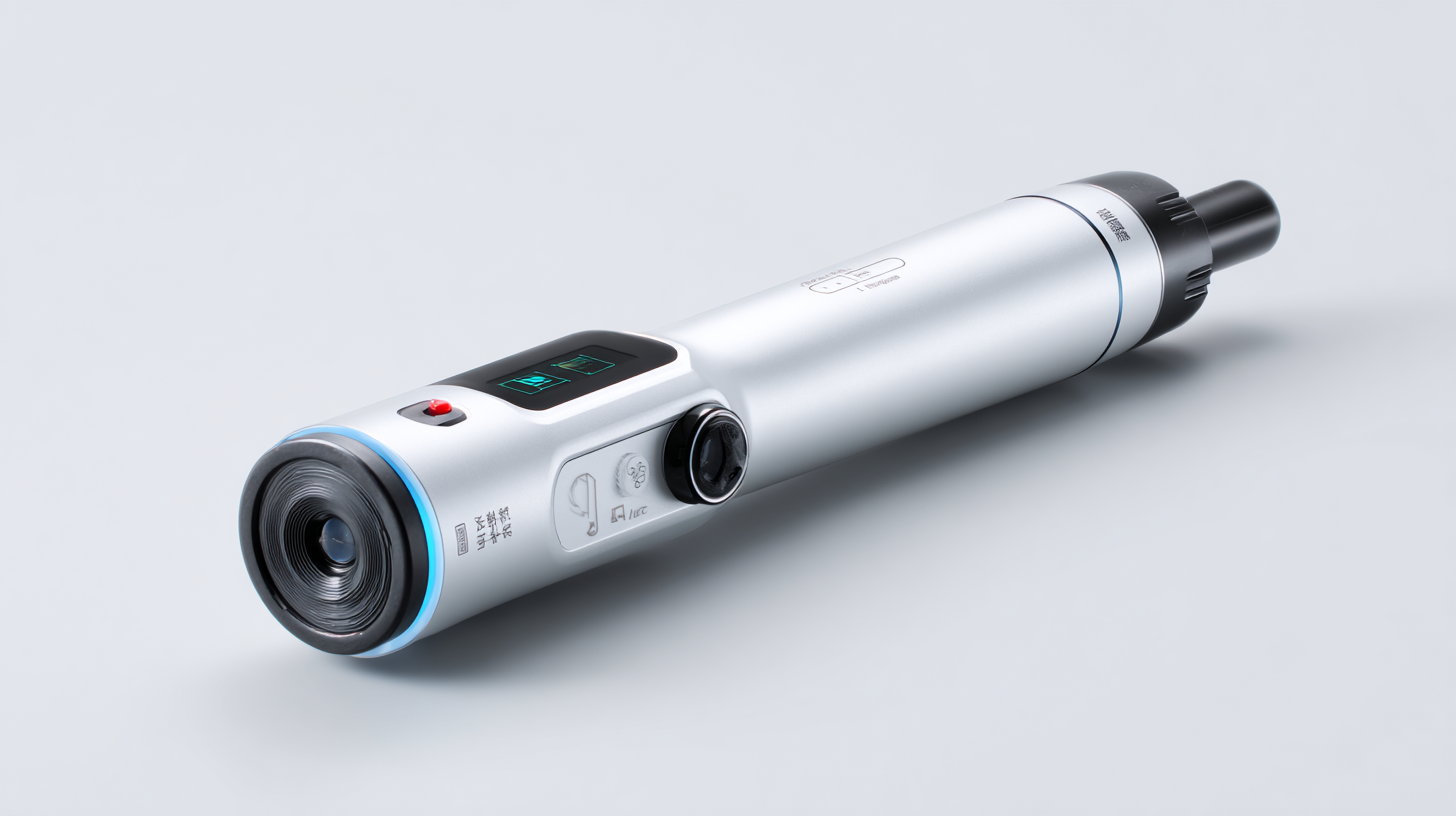Exploring the World of Bluetooth Endoscopes: The Future of Wireless Inspection Technology
In recent years, the rapid advancements in medical technology have led to innovative tools that enhance the inspection and diagnosis process. One such groundbreaking invention is the Bluetooth Endoscope, a device that seamlessly integrates wireless technology with traditional endoscopic procedures. This evolution allows for improved accessibility, mobility, and convenience, enabling healthcare professionals to perform detailed inspections without the limitations of cumbersome cables. As the demand for minimally invasive diagnostic solutions grows, the Bluetooth Endoscope is paving the way for a future where precision and efficiency in clinical settings are prioritized. In this exploration of wireless inspection technology, we will delve into how Bluetooth Endoscopes are transforming the field, examining their functionality, applications, and the potential they hold for various industries beyond healthcare. Join us as we uncover the myriad possibilities that Bluetooth Endoscopes present and their significant impact on modern inspection practices.

Advancements in Bluetooth Endoscope Technology for Inspection Purposes
The advancements in Bluetooth endoscope technology have revolutionized the field of inspection across various industries. These wireless devices offer the convenience of remote viewing, allowing technicians to conduct inspections in hard-to-reach areas without the need for cumbersome cables. With high-resolution cameras and enhanced connectivity features, Bluetooth endoscopes provide clear imagery, making it easier to identify issues in pipes, machinery, and other equipment. Moreover, the integration of advanced software enables real-time data sharing and analysis, enhancing the efficiency of inspections.
Tips for choosing the right Bluetooth endoscope include considering the camera resolution, flexibility of the probe, and battery life. Make sure to select a model that is appropriately sized for the applications you will be using it for. Additionally, check for compatibility with your devices, as some endoscopes offer specific software that enhances usability on smartphones or tablets.
As the technology continues to advance, we can expect further developments in Bluetooth endoscopes, such as improved imaging technologies and increased durability. This will only enhance their applicability in fields ranging from automotive repair to medical inspections, making them an essential tool for professionals who prioritize efficiency and accuracy in their work.

Benefits of Wireless Endoscopes in Medical and Industrial Applications
 Wireless endoscopes have become a revolutionary tool in both medical and industrial fields, leveraging Bluetooth technology to enhance inspection capabilities. In the medical sector, these devices allow for real-time imaging without the constraints of traditional wired systems. Surgeons and doctors can now maneuver freely, significantly improving precision during procedures. This wireless connection also facilitates immediate data sharing with colleagues or specialists, enabling better collaborative decision-making.
Wireless endoscopes have become a revolutionary tool in both medical and industrial fields, leveraging Bluetooth technology to enhance inspection capabilities. In the medical sector, these devices allow for real-time imaging without the constraints of traditional wired systems. Surgeons and doctors can now maneuver freely, significantly improving precision during procedures. This wireless connection also facilitates immediate data sharing with colleagues or specialists, enabling better collaborative decision-making.
In industrial applications, wireless endoscopes are transforming maintenance and inspection tasks. They allow technicians to easily access hard-to-reach areas inside machinery or infrastructure without extensive disassembly. The portability of these devices not only saves time but also reduces costs related to equipment downtime. Moreover, the ability to stream live video and capture high-definition images ensures that inspections are thorough and effective, leading to enhanced safety and reliability in operations.
Overall, the advancements in wireless endoscopy are paving the way for safer and more efficient practices across various sectors.
Comparative Analysis: Bluetooth Endoscopes vs. Traditional Endoscopy Methods
Bluetooth endoscopes represent a significant advancement in inspection technology, enabling wireless capabilities that traditional methods cannot match. One major advantage of Bluetooth endoscopes is their portability and ease of use. Unlike traditional endoscopes, which often require cumbersome cables and extensive setup, Bluetooth models can connect seamlessly to smartphones or tablets. This allows for real-time image capture and sharing, enhancing collaboration among medical professionals or technicians during inspections.
Moreover, Bluetooth endoscopes provide greater flexibility in operation. Traditional endoscopy often involves more invasive procedures and a longer recovery time for patients. In contrast, Bluetooth technology offers a less invasive approach, enabling quicker examinations and minimizing patient discomfort. However, one must consider the potential limitations, such as battery life and image resolution, which may not yet match that of high-end traditional systems. As technology progresses, the balance between convenience and performance will likely continue to evolve, making Bluetooth endoscopes a compelling alternative in both medical and industrial applications.
Future Trends in Wireless Inspection Technology: What to Expect
The future of wireless inspection technology is bright, particularly with the advancement of Bluetooth endoscopes. According to a recent report by MarketsandMarkets, the global market for medical endoscopes is projected to reach $43.8 billion by 2025, growing at a CAGR of 6.5%. This growth is driven by the increasing demand for minimally invasive procedures and the rising prevalence of chronic diseases, which necessitate advanced diagnostic tools. Bluetooth endoscopes stand out by offering the convenience of wireless operation, enabling real-time data transmission and enhanced mobility for healthcare professionals.
As we look ahead, key trends are emerging in this sector. The integration of artificial intelligence with Bluetooth endoscopes is set to revolutionize diagnostics, allowing for quicker and more accurate interpretations of endoscopic images. Moreover, the 5G network rollout will significantly enhance data transfer speeds and connectivity, paving the way for remote expertise during procedures.
**Tips:** When choosing a Bluetooth endoscope, consider factors such as resolution, battery life, and compatibility with your devices to ensure optimal performance. Keep an eye on the latest technology advancements, as features like AI-driven image analysis can greatly enhance your inspection capabilities. Lastly, ensure regular software updates to maintain device security and functionality.
Bluetooth Endoscopes: Adoption Trends Over the Years
This chart illustrates the increasing adoption rate of Bluetooth endoscopes from 2018 to 2023, highlighting the growing interest and technological advancements in wireless inspection technology.
Challenges and Considerations in Adopting Bluetooth Endoscopes
The rapid advancement of Bluetooth endoscopes offers remarkable opportunities for wireless inspections across various fields, yet their adoption poses several challenges that need consideration. One significant hurdle is the potential for connectivity issues in environments saturated with electronic devices. Users may experience intermittent connections or lag, which can be detrimental during critical inspections. Ensuring that the Bluetooth endoscope is used in a space with minimal interference can significantly improve performance.
**Tip:** When preparing for an inspection, always conduct a quick connectivity test to ensure your Bluetooth endoscope maintains a strong signal throughout the intended workspace.
Another challenge lies in the technical expertise required to operate these devices effectively. While Bluetooth endoscopes simplify many aspects of inspection, users must still be familiar with operating Wi-Fi enabled devices and interpreting the images they capture. This learning curve can be daunting for some professionals who may not have extensive experience with technology. Providing adequate training and resources on how to utilize these devices will enhance their effectiveness and user confidence.
**Tip:** Consider organizing training sessions or workshops when introducing Bluetooth endoscopes to your team to bridge the knowledge gap and foster familiarity.
Ultimately, addressing these challenges head-on will pave the way for wider acceptance and integration of Bluetooth endoscopes into various inspection practices, unlocking their full potential in the field.
Exploring the World of Bluetooth Endoscopes: The Future of Wireless Inspection Technology - Challenges and Considerations in Adopting Bluetooth Endoscopes
| Feature | Description | Advantages | Challenges |
|---|---|---|---|
| Wireless Connectivity | Bluetooth technology for seamless inspection. | Increased mobility and flexibility. | Potential connection issues in certain environments. |
| Image Quality | High-definition imaging capabilities. | Better diagnostics and detailed inspections. | High costs for superior imaging sensors. |
| Power Source | Rechargeable batteries for wireless operation. | Eliminates cumbersome wires. | Limited battery life can interrupt inspections. |
| Portability | Lightweight and compact designs. | Easier transport and setup. | Might be less durable than traditional endoscopes. |
| User Interface | Intuitive app-based controls. | Simplifies operation for users. | Potential technical barriers for less tech-savvy users. |
Related Posts
-

Discover the Hidden Secrets with a Wifi Endoscope Camera for Home Inspection
-

Best Video Endoscope Quality Manufacturing in China for Global Export
-

Navigating Tariff Challenges How Best Borescope Endoscope from China Thrives in a Competitive Market
-

The Future of Best Portable Endoscopes A 2025 Industry Analysis and Comparison of Leading Technologies
-

Borescope vs Endoscope Understanding the Key Differences in Industrial Applications
-

7 Essential Tips for Choosing the Best Wifi Endoscope Camera

